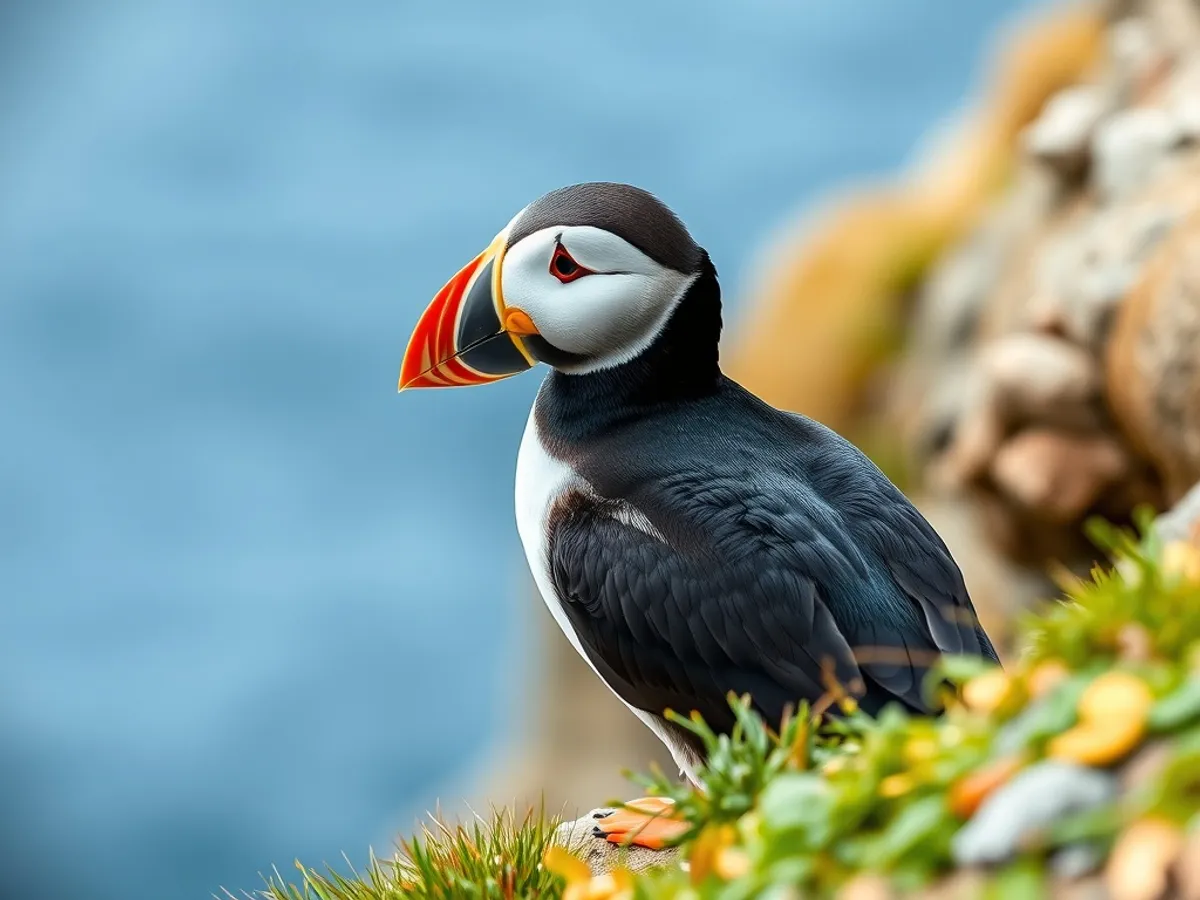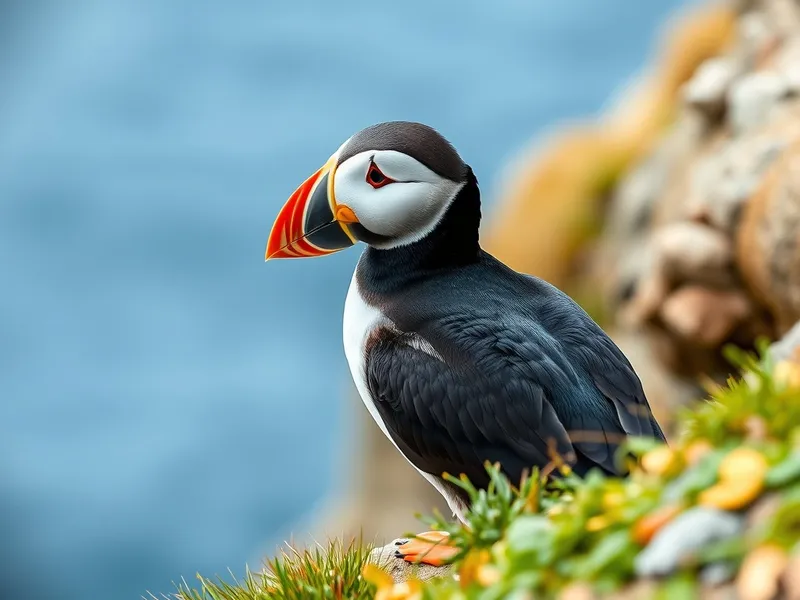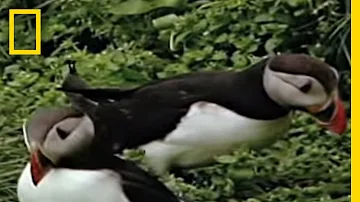
Horned Puffin
Fratercula corniculata

Meet the Horned Puffin
The Horned Puffin is a striking seabird known for its bold black and white plumage, bright orange beak, and the small fleshy black 'horns' above its eyes, which give the species its name. This puffin breeds along rocky cliffs and islands of the North Pacific, particularly in Alaska and eastern Russia, where it nests in crevices and among boulders. It is an adept diver, using its wings to swim underwater in pursuit of small fish and marine invertebrates. Outside the breeding season, horned puffins spend months at sea, returning to land only to nest and raise their young.
Classification
Bird
Habitat
Coastal cliffs and offshore islands
Diet
Carnivore
Lifespan
15-20 years
Conservation
Least Concern
Weight
500–700 grams
📖Fascinating Facts
Expert Fisher
Horned puffins can catch and hold several small fish in their beak at once by using their rough tongue and unique jaw structure.
Remote Nester
They nest on inaccessible cliffs and rocky islands, often laying a single egg in deep crevices to protect it from predators.
Impressive Flyers
Despite their compact size, horned puffins can fly up to 88 km/h (55 mph) by rapidly flapping their wings.
📋Detailed Description
The Horned Puffin (Fratercula corniculata) is a medium-sized auk, measuring 36–38 cm (14–15 in) in length with a wingspan of 56–58 cm (22–23 in) and weighing approximately 500–600 grams (1.1–1.3 lbs). Its most distinctive features include a striking black 'horn' of skin above each eye during the breeding season, a large, laterally compressed, vividly colored bill with a yellow base and orange tip, and bold black-and-white plumage. The face is white with a black cap extending from the nape to the eyes, while the back, wings, and tail are black, and the underparts are white. Horned Puffins are highly adapted for aquatic life, with short, strong wings used for 'flying' underwater and webbed feet set far back on the body for efficient propulsion. On land, they are somewhat awkward, walking with a waddling gait. Their eyes are encircled by a fleshy, yellow orbital ring, enhancing their visual acuity underwater. During the non-breeding season, facial ornamentation and bill coloration fade, and the birds spend months at sea, rarely coming to land. Horned Puffins are colonial nesters, often forming dense aggregations on steep, rocky cliffs or talus slopes, where they excavate burrows or use natural crevices for nesting. Their vocalizations are generally low growls or grunts, used in social interactions within colonies. The species is monogamous, with pairs often reuniting at the same nest site year after year. Their lifespan in the wild is estimated at 20–25 years, with delayed sexual maturity typically reached at 4–5 years of age.
💡 Did you know?
Horned puffins spend most of their lives far out at sea, sometimes not touching land for months at a time.
🔬Research & Sources
Wikipedia Summary
The horned puffin is an auk found in the North Pacific Ocean, including the coasts of Alaska, Siberia and British Columbia. It is a pelagic seabird that feeds primarily by diving for fish. It nests in colonies, often with other auks.
Last Modified: 5/17/2025
🎭Behavior & Social Structure
Horned Puffins are diurnal, with peak activity during daylight hours, especially at breeding colonies. At sea, they are solitary or found in small groups, but during the breeding season, they become highly social, engaging in mutual preening, billing, and vocal displays to reinforce pair bonds and establish territory. Their primary feeding strategy is pursuit diving: they use their wings to 'fly' underwater, reaching depths of up to 30 meters (98 ft) and remaining submerged for up to a minute. Diet consists mainly of small schooling fish such as sand lance, capelin, and herring, supplemented by squid and crustaceans. Puffins carry multiple fish crosswise in their bills, thanks to a specialized hinge in the upper mandible and backward-facing spines on the palate. Foraging trips can extend up to 100 km (62 mi) from the colony. On land, they are vigilant against predators such as gulls and foxes, often engaging in aggressive displays to defend nest sites. Daily routines at colonies include nest maintenance, courtship, and feeding of chicks, with adults alternating between foraging at sea and attending the nest.
👶Reproduction & Life Cycle
Breeding occurs from late May to August, with pairs forming long-term monogamous bonds. Courtship involves synchronized swimming, billing, and mutual preening. Nests are constructed in rock crevices, under boulders, or occasionally in burrows up to 1.5 meters (5 ft) deep, lined with grass, feathers, and moss. The female lays a single white egg per season. Both parents share incubation duties for 40–42 days, alternating shifts of several hours. After hatching, the chick (known as a puffling) is brooded for the first few days and then left alone while both parents forage. Chicks are fed whole fish and grow rapidly, fledging at 40–50 days old. Fledglings depart the nest at night, making their way to the sea independently. There is no post-fledging parental care. Breeding success is closely tied to food availability and predation pressure.
🛡️Adaptations & Survival
Horned Puffins exhibit several remarkable adaptations for their marine lifestyle. Their compact, waterproof plumage provides insulation in cold northern waters. The large, triangular bill is not only a visual signal during courtship but also an efficient tool for carrying multiple fish. Their wings are relatively short and strong, optimized for underwater propulsion, while webbed feet provide steering. The eyes are positioned for binocular vision, aiding in depth perception underwater. Seasonal changes in bill color and facial ornamentation serve as breeding signals and regress outside the breeding season to reduce predation risk. Physiologically, they have high myoglobin concentrations in muscle tissue, supporting extended dives. Their salt glands enable them to excrete excess salt from ingesting seawater.
📚Research Sources
🎨Cultural Significance
Horned Puffins hold cultural significance for Indigenous peoples of Alaska and the Russian Far East, who have traditionally harvested their eggs and feathers. Their striking appearance has made them a symbol of northern coastal wildlife, frequently featured in regional art and ecotourism promotion. Unlike the Atlantic Puffin, they have a more limited role in folklore but are occasionally referenced in local myths as symbols of agility and perseverance.
🔬Recent Research & Discoveries
Recent research has focused on the effects of ocean warming and prey shifts on Horned Puffin reproductive success, with studies using GPS tracking to map foraging ranges and dive profiles. Stable isotope analysis has provided insights into dietary shifts over time. Genetic studies have clarified their relationship to other puffin species, supporting the monophyly of the genus Fratercula. Ongoing monitoring of colonies in Alaska and Russia is tracking population trends and the impact of invasive species. There is also interest in the biomechanics of their underwater flight, with high-speed video and modeling shedding light on their remarkable diving efficiency.
🎥Wildlife Videos

Puffin Hunts Fish To Feed Puffling | Blue Planet II | BBC Earth
Taken From Blue Planet II This bold cinematic experience takes viewers on a magical adventure across the greatest, yet least ...
BBC Earth

Horned Puffin Description, Characteristics and Facts!
Hi, this is animal planet tv channel. my channale name animal planet tv . Animal videos and documentaries are offered on my ...
animal planet tv

Atlantic Puffins! Documentary. #thehowtoacademy
Dive into the fascinating world of Atlantic puffins in this eye-opening documentary! Uncover the secret lives of these colorful ...
Pristine Planet 4K

Interesting facts Puffin Birds | The Secret Lives Of Puffins (Wildlife Documentary) Scoop of the Day
Atlantic_Puffin #Beautiful_Bird #World_Nature #puffin #atlanticpuffin #hornedpuffin #tuftedpuffin Puffins are any of three ...
Scoop of the Day

Puffins | National Geographic
About National Geographic: National Geographic is the world's premium destination for science, exploration, and adventure.
National Geographic

Atlantic Puffin Description, Characteristics and Facts!
Hi, this is animal planet tv channel. my channale name animal planet tv . Animal videos and documentaries are offered on my ...
animal planet tv
🌍Habitat Information
The Horned Puffin typically inhabits Coastal cliffs and offshore islands environments. Horned Puffins have adapted to their environments with specialized features and behaviors.
Primary Habitat:
Coastal cliffs and offshore islands
More detailed habitat information will be available soon.
🛡️Conservation Status
The Horned Puffin is currently classified as Least Concern. Conservation efforts are crucial for preserving this species for future generations.
Common Threats:
- 🏠Habitat loss and fragmentation
- 🌡️Climate change impacts
- 🎯Hunting and poaching
- 🏭Human-wildlife conflict
⚠️Threats & Conservation Challenges
While currently listed as Least Concern by the IUCN, Horned Puffins face several threats. Climate change impacts prey availability and distribution, potentially reducing breeding success. Oil spills, plastic pollution, and entanglement in fishing gear pose direct risks, particularly during the non-breeding season at sea. Introduced predators such as Arctic foxes and rats on nesting islands can devastate colonies. Human disturbance, especially from tourism and coastal development, can lead to nest abandonment. Despite these challenges, the global population is considered stable, with an estimated 1–2 million individuals, but local declines have been noted in some areas.
🔬Scientific Classification
Scientific Name
Fratercula corniculata
Classification Hierarchy
🔍 About Taxonomic Classification
Taxonomic classification is a hierarchical system used by scientists to classify and organize living organisms based on shared characteristics and evolutionary relationships.
The system moves from broad categories (Kingdom) to increasingly specific ones, with each animal's scientific name typically consisting of its Genus and species.
📝Community Notes
Share your observations and insights about the Horned Puffin with our community of wildlife enthusiasts.
Join Our Community
Sign in to share your observations and connect with fellow wildlife enthusiasts.
Sign In to ContributeNo community notes yet
Be the first to share your observations about the Horned Puffin!
Explore Horned Puffin
Select a tab above to learn more about this amazing animal.
📸Photo Gallery
No photos available for this animal yet.
🌟Discover More Wildlife
Continue your journey of discovery with more fascinating animals from our database
